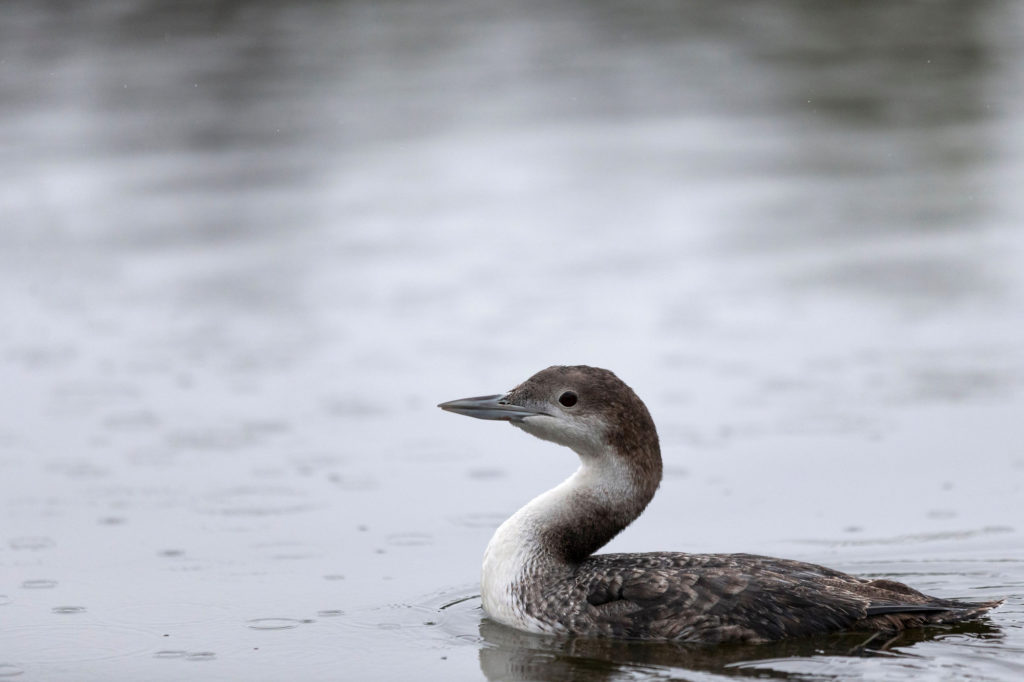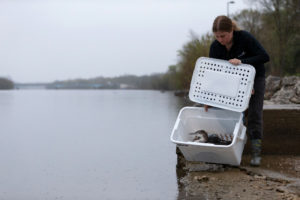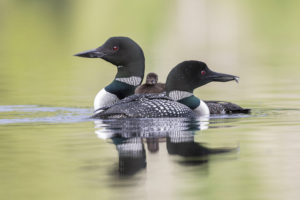Wildlife Hospital Provides Care Before April Release Back to the Wild

It had been a hectic morning for Chris and Connie Copeland at their Upper Arlington home on April 10 as they stayed by the phone to hear updates about the imminent arrival of their new grandchild. In the midst of the action, they heard something ping against their glass patio door.
As avid birders they were both surprised and amazed to see a Common Loon outside the glass pecking intently before it turned and huddled in a corner of the patio. After landing on the cement in the yard the bird appeared disoriented, Connie Copeland said, and they knew they would need to get some help.
“We called around to other friends who are birders and we eventually contacted Ohio Wildlife Center’s InfoLine for assistance,” Copeland said. Volunteer Wendy King took the call and after viewing a video of the bird that the Copelands sent her, she helped dispatch SCRAM! Wildlife Control technician Justin Pope to their home.
“The call came from residents in Upper Arlington who knew that the large, apparently stranded bird on their porch was a Common Loon,” Pope said. “I had seen loons in the wild, but never this close. I focused on quickly and gently containing the bird, while avoiding its dagger-like beak,” he said. “Inside my truck, the loon vocalized all the way to the Wildlife Hospital.”
Once heard, the sound of a loon can never be forgotten. The mournful wail, something like the howl of a wolf, is given by both male and female loons when they have become separated and want to reunite on their quiet, clear lakes at dusk. Greg Budney, of the Cornell Lab of Ornithology, describes the wail calls as a loon conversation that conveys, “I’m here. Where are you?” Moments later, the mate answers, “I’m over here.” Loons are monogamous, and pair bonds typically last about five years.
At the Wildlife Hospital the loon was assessed and slight dehydration was noted, but the bird swam well in the testing pool and by the end of the day after rest and fluids it was crated and transported to Griggs Reservoir for release.
Griggs Reservoir was chosen because it is near where the bird was rescued, and Common Loons are often seen there during winter months. On the west bank of the water Wildlife Hospital staff member Kristi Krumlauf lifted the lid of the transport container to set the loon free.

“It was a bit rainy, and the loon headed straight out to the water and started preening and diving, and making the characteristic loon call as if it were checking to see if anyone else was around. It was just the behavior I wanted to see,” Krumlauf said.
Perfectly adapted for an aquatic life, Common Loons sit low in the water, with powerful feet positioned far back on their body—ideal for underwater propulsion, sharp twists and even abrupt flip-turns – all in pursuit of the fish (perch and sunfish) that make up the bulk of their diet. Unlike most birds, loons have solid bones that make them less buoyant and better at diving. They have been found at depths of more than 200 feet chasing down prey. Their ruby-red eyes may allow them to filter light and see better underwater. When fish are scarce or the water is too murky for them to see well, they can switch to crustaceans, leeches, snails, and aquatic insect larvae.

Because this aquatic bird cannot walk well on dry land, everything – from taking flight and landing to caring for their chicks – takes place in or near their watery world. They require large expanses of water for landings and take-offs and when they are grounded on pavement they often need to be rescued and relocated back to a large body of water. During migration they can mistake wet pavement for water and after landing on the hard surface they end up stranded and unable to take off.
The activities of people, particularly motorboats, can disturb loons, and in the Midwest they have been driven from breeding sites in Illinois, Indiana, Iowa, and Ohio. A host of additional threats include lead poisoning (from fishing sinkers), mercury from the burning of coal that can pollute lakes through rainfall, inadvertent mortality in commercial fishing nets, acid rain and oil spills.
The Common Loon is a sentinel species, an indicator of the health of lakes and ponds. Because of their lifespan (sometimes more than 30 years), and their voracious appetites (a family of two adults and two chicks can consume 1,000 pounds of fish in one season), the health and breeding success of loons can reveal long-term trends in the health of our environment. Loon biologists have compared them to canaries in the coal mine.
Although Common Loons no longer nest in Ohio, they pass through, stopping to rest and feed in lakes and reservoirs.